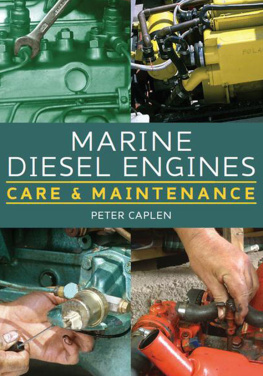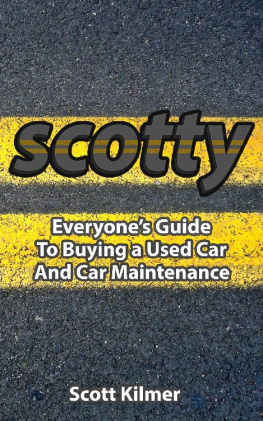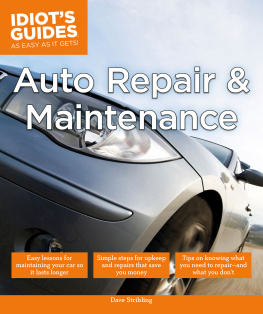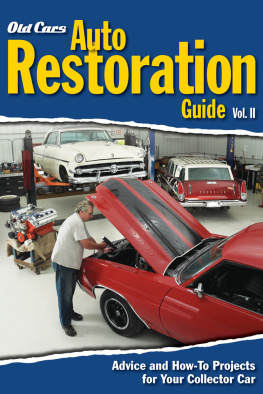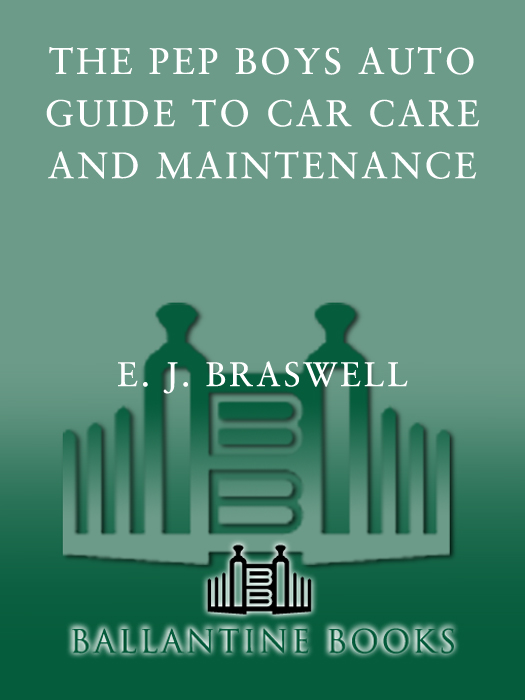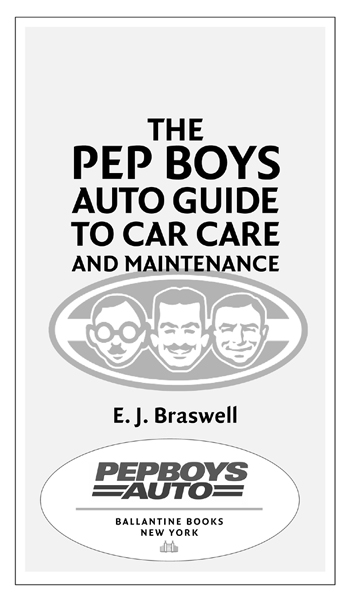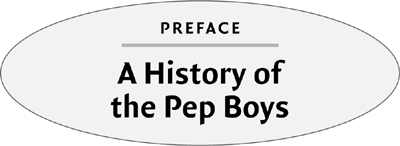Note: This publication is intended to convey a basic understanding of the principles of car maintenance. It is sold with the understanding that the author, publisher, and The Pep Boys are not engaged in rendering professional services in our book. If the reader requires personal assistance or advice, a competent professional should be consulted.
The author, publisher, and The Pep Boys specifically disclaim any responsibility for any liability, loss, or risk, personal or otherwise, which is incurred as a consequence, directly or indirectly, of the use and application of any of the contents of this book.
A Ballantine Books Trade Paperback Original
Copyright 2005 by The Pep BoysManny, Moe, and Jack
All rights reserved.
Published in the United States by Ballantine Books, an imprint of The Random House Publishing Group, a division of Random House, Inc., New York.
All photographs are courtesy of The Pep Boys.
Timeline created by Marian Calabro.
BALLANTINE and colophon are registered trademarks of Random House, Inc.
Library of Congress Cataloging-in-Publication Data is available from the publisher upon request.
eISBN: 978-0-307-48947-0
Ballantine Books website address: www.ballantinebooks.com
v3.1
CONTENTS
PREFACE
A History of The Pep Boys
CHAPTER 1
A Tutorial of Your Car and How It Works
CHAPTER 2
Basic Car Care Maintenance That You Can Do Yourself
CHAPTER 3
Safety TipsPreventive and Emergency
CHAPTER 4
Service and Repair
CHAPTER 5
Appearance and Accessories
CHAPTER 6
A Timeline of Cars, America, and the Pep Boys
CHAPTER 7
Glossary of Terms
CHAPTER 8
Important Records for You to Keep
ACKNOWLEDGMENTS
This book is for everyone at Dynasty: Peter, Chris, Pedro, Kim, Henryand everyone else whose name I should know by now. I honestly could not have finished the book without you.
Thank you to Bruce Chidsey, who made sure all the information in the book was accurate and user friendly.
Special thanks to cousin Steve, Sheperd Todd, Maggie Libby, and my editor/driving companion, Jen Osborne.
Manny, Moe, and Jack: Trust Is the Chassis
In 1921, four street-smart entrepreneurs from South Philadelphia each pitched in $200 to start an automotive accessories business.
Emmanuel Manny Rosenfeld, two MoesMaurice Moe Strauss and Moe Radavitzand W. Graham Jack Jackson were World War I navy buddies.
With their pooled $800 the partners rented a store at 7-11 North 63rd Street in West Philadelphia; there was just enough left over to cover an outlay of $63 to a car parts wholesaler and a few weeks of salaries for themselves. The address seemed lucky; it gave them the idea to include a pair of dice in their early signs and ads. As the four were setting up shop and suggesting names to go with it, Moe Strauss happened to glance at a carton of Pep Valve Grinding compound: Pep Auto Supply Company became the companys name for its first two years. The Pep Boys name arose courtesy of a policeman at 63rd and Market, who would advise motorists when he stopped them for equipment violations to go see the boys at Pep for a replacement oil wick (what passed for headlights in those days).
Moe Strauss was the guiding force. After leaving the navy he had tried to start his own auto accessories store twice. While both attempts failed, Moe stood firm in his belief that there was a need for such stores; car ownership throughout the country was skyrocketing. Finally, with help from the right partnersand a job as a cigar salesman to tide him overhe succeeded on his third attempt.
Manny was a great foil for Moe, with a head for figures and an easygoing personality that balanced Moes quick temper. He also brought retail experience to the mix from a stint selling shoes at Lit Brothers, a leading Philadelphia department store at the time.
Moe Radavitz brought money and personal energy to the business, but left after a few years, leaving only one Moe; Moe Strauss.
There were actually two Jacks; unlike Manny Rosenfeld and Moe Strauss, neither one stayed with Pep Boys for long. The first was W. Graham Jackson, a navy buddy of Manny and Moes and a cofounder of the business. Jacks boyish face appeared in very early logos. He must have been important to the business because he drew the biggest salary: $25 a week. After he left, one of Moes brothers, Isadore (Izzy), took Jacks placeboth in the company and as the caricature of Jack. Izzy even began signing his business letters I. M. Jack Strauss. In 1929, however, he struck out on his own. He moved to New York and founded Strauss Stores, which became R&S/Strauss and is now Strauss Discount Auto.
Sears, Roebuck & Co. had gotten into the auto accessories business early through its mail-order catalog, but Manny and Moe believed that people preferred to shop locally. Only in mortar-and-brick stores could customers touch the goods and ask for advice. An early slogan promised: Theres a Pep Store Near Your Door.
Pep Boys offered a further advantage: It was the first chain in the country to specialize in auto accessories rather than just offer them as a sideline. If they could keep prices low, customer service high, and the work ethic strong, there was no reason they shouldnt dominate the automotive aftermarket that they helped pioneer.
Stores stayed open six days a week, and the founders worked on Sundays as well: Local blue laws forbade them from actually opening the store. Life for us at that time began around 6:15 A.M. and continued on until about 1:00 A.M, seven days each and every week, Manny remembers. There was not much opportunity to reflect upon the past or dream of the future. Rather, we were more concerned about where the next meal was coming from.
All the hard work paid off a few years later when they opened their first branchagainst the advice of their friends.

Pep Boys outfitted Rear Admiral Richard E. Byrds second Antarctic expedition with two Kellett K2 Autogiros (a small, maneuverable craft with a plane fuselage and helicopter-like rotors), a pilot, and a large supply of Pep Boys Snowman brand antifreeze. Pictured here after the September 22, 1933, presentation ceremony are Emmanuel Manny Rosenfeld (front row, second from left), Admiral Byrd (front row, third from left), and Maurice Moe Strauss (second row, left).
In 1923, with the business on solid footing, Manny and Moe were finally able to take a vacation/business research trip: a cross-country journey from Philadelphia to Los Angeles in a brand-new Model T. The desire for long-distance car travel was burning like a fever among Americans, spawning a new landscape of motels, campgrounds, roadside eateries, and billboards. One particular sign that caught their eye was for a dress shop called Minnie, Maude & Mabels. They came back home with Manny, Moe & Jack and the idea of opening stores in southern California.


